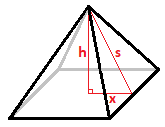Perplexing Pyramid Problem
A certain right pyramid with a square base has the same numerical surface area as its volume. If it is also the only right pyramid with a square base to have that certain surface area and volume, what is its height?
The answer is 12.
This section requires Javascript.
You are seeing this because something didn't load right. We suggest you, (a) try
refreshing the page, (b) enabling javascript if it is disabled on your browser and,
finally, (c)
loading the
non-javascript version of this page
. We're sorry about the hassle.
2 solutions
Great solution!
David, good problem,but I found the wording confusing. By equating V to S, I essentially came up with Stephen's equation for v vs. h, and then concluded that here are infinitely many answers that would have surface area and volume numerically equal. For a particular volume, there would be only 1 h, but many volumes with equal areas. I enjoy your problems in any case. Thank you.
Log in to reply
I struggled with the wording of this problem. Any suggestions?
Log in to reply
Dave, it's hard to know what you were after. Consider the following: If h = 12, V =288, Area = 288, If h = 9, V =324, area = 324, if h = 15, V = 300, area = 300
Log in to reply
@Edwin Gray – Perhaps the question is: of all possible right square pyramids, what is the height when the Volume equals surface area, and they have the minimum value? Then Stephen's derivative would make sense.
@Edwin Gray – When V = S = 324, there are two possible h values: h = 9 and h = 18. When V = S = 300, there are two possible h values: h = 10 and h = 15. But when V = S = 288, there is only one h value: h = 12. This is the only V = S to have one way to make a pyramid, which is why this h value is the answer.
Let the h be the height of the pyramid, s be the slant height, 2 x be the side of the square base, V be the volume, and S be the surface area.

By Pythagorean's Theorem, x 2 + h 2 = s 2 , so S = 4 x 2 + 4 x x 2 + h 2 and V = 3 1 4 x 2 h . Since S = V and x = 4 h 3 V , substituting into S we have V = 4 ( 4 h 3 V ) 2 + 4 4 h 3 V ( 4 h 3 V ) 2 + h 2 which simplifies to 1 2 h 2 − V h + 6 V = 0 (for V > 0 ), which by the quadratic equation solves to h = 2 4 V ± V 2 − 2 8 8 V .
To be the only right pyramid to have that volume, the discriminant V 2 − 2 8 8 V = 0 , which is at V = 2 8 8 (for V > 0 ), and this volume gives the pyramid a height of h = 2 4 2 8 8 ± 0 = 1 2 .
Dave, good show. I think conceptually, we are saying the same thing. It's like the values of h that provide volume = area are on a parabola, and the solution you want is at the apex, where there is only 1 point.
Let a be the base side length and let h be the height.
S = V a ( a + a 2 + 4 h 2 ) = 3 1 a 2 h 3 a + 3 a 2 + 4 h 2 = a h 3 a 2 + 4 h 2 = a h − 3 a 9 ( a 2 + 4 h 2 ) = a 2 h 2 − 6 a 2 h + 9 a 2 3 6 h 2 = a 2 h 2 − 6 a 2 h a 2 = h 2 − 6 h 3 6 h 2 = h − 6 3 6 h
Plugging back into the volume equation:
V = 3 1 a 2 h = h − 6 1 2 h 2
We are told that for a particular volume, there should only be one value of h at which it occurs. This is equivalent to saying that the h value should correspond to a local minimum or maximum of V , when V is plotted against h .
d h d V = 0 ( h − 6 ) ( 2 4 h ) − 1 2 h 2 = 0 1 2 h 2 = 1 4 4 h h = 1 2